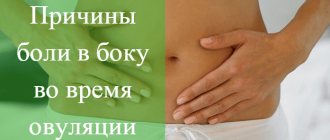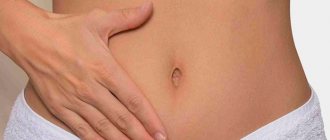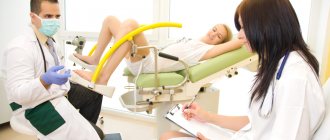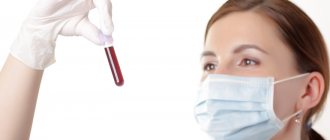Along with weight gain, breast swelling, and mood swings, all women experience a variety of symptoms of premenstrual syndrome. Aching sensations in the stomach and cravings for sweets can be explained by hormone surges. But many people are perplexed why their lower back hurts when their period approaches. Back discomfort is one of the signs of dysmenorrhea or painful menstruation.
Causes of lower back pain during menstruation
The causes of lower back pain can be physiological changes in the body, exacerbation of neurological diseases, pleurisy or diseases of the genitourinary organs.
Pain during menstruation caused by physiological changes in the body
- During menstruation, a woman's body produces increased production of prostaglandins. These biologically active substances are involved in the regulation of various physiological processes. During uterine contractions that occur during menstruation, due to the action of prostaglandins on the nerve endings of the cells, the signal is transmitted to the brain. A painful sensation occurs. Pain sensations spread from the uterus to the lower back and other parts of the body. They are called radiating pain.
- Painful sensations may occur due to the location of the uterus. If it is shifted to the back, it begins to compress the nerve fibers. In this case, the woman feels pain in the lower abdomen, in the lumbar region and in the sacrum.
- The ovaries produce estrogen (the female sex hormone). During the reproductive period, its level is maximum. This hormone increases the sensitivity of receptors and enhances muscle tone. Muscle tension in the pelvic area is also the reason why the lower back hurts during menstruation.
Causes of lower back pain during menstruation
The content of the article:
If your lower back hurts before your period, most often the cause of unpleasant symptoms is the physiological processes occurring in the body. This situation is considered normal in medicine.
The pain in the lower abdomen is predominantly nagging, radiating to the lumbar region. It persists even after bleeding begins. Doctors explain this phenomenon by the fact that shortly before the appearance of discharge and during critical days, the ligaments and muscles of the pelvic area are tense. Increased tone of the uterus promotes the expulsion of exfoliated endometrium from the cavity of this organ. Tension is transferred to nearby structures, causing severe or moderate pain.
The reasons why your back hurts during menstruation do not end there. For example, the same hormonal imbalance provokes severe pain. This often happens in women after 30 years of age, when they experience a jump in estrogen levels.
Do you experience lower back pain during your period?
Yes, sometimes No
Incorrect placement of the uterus the abdominal cavity can cause pain that spreads to the lower back and lower abdomen . If the organ deviates back, then during menstruation the nerves of the lumbar region are irritated.
Sometimes painful sensations are associated with a woman's use of an intrauterine contraceptive device. Incorrect selection of the spiral , individual anatomical features of the uterus can cause worsening of the outflow from the hollow organ. Then the pain spreads to the lower back.
Often pain is associated with inflammation affecting the pelvic organs - ovaries, fallopian tubes, uterus, kidneys, bladder. In such cases, dangerous diseases make themselves felt with painful sensations of varying intensity.
Characteristic symptoms
If nagging pain during menstruation appears in the abdomen and then moves to the lower back, then the cause is uterine contractions. They recur periodically and disappear with the cessation of menstruation. These pains are associated with impaired blood flow from the uterus during menstruation and the effect of prostaglandins on nerve cells.
Increased pain during menstruation, which occurs against the background of sudden weight loss and sleep disturbances, indicates hormonal disorders in the body. The cause of such disorders may be a disease of the thyroid gland. It is necessary to be examined by an endocrinologist and take hormone tests in order to prescribe treatment.
The occurrence of “lumbago” in the lower back during menstruation or nagging pain extending to the chest or leg area may indicate neurological diseases (osteochondrosis), aggravated during menstruation, or a hernia.
Painful sensations during menstruation can intensify with insufficient removal of fluid from the body due to impaired kidney function; swelling occurs in the tissues, increasing pain.
Dull pain in the kidney area (sometimes on one side) may be a consequence of urolithiasis. Sometimes the back in this area begins to hurt during menstruation due to pleurisy. Usually, such sensations only intensify during menstruation. These diseases can also be distinguished by an increase in temperature.
Severe nagging pain in the lower back and abdomen during menstruation can be symptoms of inflammatory diseases in the uterus and ovaries. At the same time, pain also exists in the period between menstruation, accompanied by discharge of various types.
Note: It is not recommended to use any medications for self-treatment. This way you can miss the onset of a serious illness. The examination will help determine the cause of lower back pain during menstruation and determine a way to alleviate the woman’s condition.
One of the symptoms of endometriosis (a disease of the uterus, which is characterized by severe pain in the abdomen and lower back during menstruation) is iron deficiency anemia. Its presence can be judged by symptoms such as pallor, shortness of breath, weakness, drowsiness, and dizziness.
Video: Causes of pain during menstruation
A little about female anatomy
The pathological structure of certain organs of the female reproductive system, most often the uterus, can cause discomfort during menstruation. If the main reproductive organ is deviated towards the spine, then when the tissues swell shortly before and during menstruation, the uterus compresses the nerve endings, causing pain in the back, in the lower abdomen and lower back.
Sometimes the lower back is pulled due to underdevelopment of the uterus. Typically, this pathology is congenital and often causes miscarriage or infertility.
The appearance of pain also depends on the condition of the pelvic floor muscles. Their fitness and ability to stretch when the uterus enlarges affects their condition during menstruation. The more elastic the muscles, the easier it is for a woman to endure not only menstruation, but also pregnancy and childbirth.
In general, mild nagging pain is natural. Unpleasant sensations in the lower abdominal cavity, lower back, rectal area, and sacrum are caused by the close relationship of pain receptors. Against the background of an increased concentration of the hormone estrogen, substances that cause pain are released.
Also, all women have different pain thresholds. This does not determine whether the lower back may hurt during menstruation, but the intensity of the discomfort varies. In some cases, a woman feels slight discomfort, but many representatives of the fair sex cannot do without potent analgesics or antispasmodics and painkillers during this period.
When should you consult a doctor for pain during menstruation?
You should consult a doctor in the following cases:
- the pain is so strong that it prevents you from doing normal activities and lasts more than 2 days;
- in addition to pain in the lower back, nausea, vomiting, intestinal upset, and headache;
- Excessive bleeding and formation of blood clots occurs;
- pain has the character of spasms, contractions (especially in women after 30 years).
The appearance of severe pain in a girl during her first menstruation may indicate pathologies in the development of the internal genital organs, so such symptoms cannot be ignored.
Ways to relieve lower back pain during menstruation
You can reduce pain with light exercise. Lying on your back, place a book on your stomach and try to lift and lower it with a little muscle tension. When your stomach is tense, count to 5. Breathe through your nose in time with the movement of your stomach. Do this several times, rest for 2 minutes, then repeat the exercise. Yoga classes are also useful.
Video: Yoga to relieve back pain during menstruation
Recommendation: During menstruation, hypothermia and colds should be avoided. It is necessary to wear warm underwear and waterproof warm shoes. Otherwise, you can develop inflammatory diseases of the appendages and bladder.
The lower back hurts more during menstruation if there is not enough calcium in the body. Therefore, during menstruation you need to eat more fermented milk products. Perhaps chocolate will help relieve pain, as it increases the production of the “pleasure hormone” in the brain.
What can cause back pain during menstruation?
Don’t wonder if your back might hurt during your period. During this period, anything can hurt. Let's look at the most popular causes of such pain.
- Hormonal imbalances are common early in the cycle. It is fraught with the appearance of various pains.
- With an increase in the amount of estrogen hormones in the female body, menstruation begins to become more and more painful. Therefore, your back may begin to ache, which was not the case before.
- An imbalance between prostaglandins and sex hormones usually leads to pain in the lower abdomen. However, due to the specifics of the body, pain syndromes can spread to the back.
- Back pain during menstruation may occur due to uterine pathology.
- In some cases, inflammation of the genitourinary system can cause aching sensations in the back and lower back.
- The water balance is disturbed. Fluid does not leave the body properly, causing tissue swelling.
There are other reasons that can provoke back pain during menstruation. If the pain does not go away, but intensifies, then you should consult a doctor. Also, a doctor's consultation may be required in cases where the back continues to hurt after the end of menstruation .
A striking example is dysfunction of the thyroid gland, which is impossible to diagnose on your own. Due to such problems, the back also hurts during menstruation. Associated syndromes such as nausea and vomiting, poor sleep and weight loss are common.
Causes of lower back pain during menstruation
PMS syndrome is observed in almost 70% of nulliparous women. Therefore, when asked whether the lower back can hurt during menstruation, the answer is positive. Almost half of them have lower back pain during menstruation. After childbirth, 50% of severe abdominal pain disappears, but back complaints remain. Everything in a woman's body is interconnected. The uterus is located in the pelvic cavity, attached by ligaments to the ilium, sacrum and frontal symphysis. During the menstrual cycle, changes constantly occur in the body under the influence of hormones.
Estrogen, which is produced by the ovaries, liver and adipose tissue under the influence of follicle-stimulating hormone of the pituitary gland, affects the uterus:
- stimulates the growth of the inner lining of the uterus after the previous menstruation;
- produces receptors for progesterone;
- affects the synthesis of luteinizing hormone (LH), which causes ovulation.
The peak of estrogen coincides with ovulation, during which the corpus luteum, a temporary endocrine gland, is formed after the release of the egg.
In the second phase of the cycle, the hormone progesterone prepares the uterus for conception:
- increases the number of glands and mucous cells on the endometrium;
- suppresses the sensitivity of the muscular layer of the uterus to prostaglandins and oxytocin - substances that cause contractions during menstruation and childbirth.
If pregnancy does not occur, then the levels of both hormones drop simultaneously. As a result of the predominance of estrogen over progesterone or an initially low level of progesterone, the hormonal balance is disrupted. Swelling, nausea, tenderness of the mammary glands, dizziness, and dyspepsia appear.
How to relieve lower back pain
A woman who always has lower back pain during menstruation should consult a specialist and undergo an examination. It will help identify the cause of the malaise.
To alleviate the condition, you need to switch to a low-salt diet 7-10 days before the start of a new cycle. This will help avoid additional stress on the body due to swelling.
If your lower back hurts badly and there are no contraindications, a pill with an antispasmodic effect, for example, No-Shpa, Spazmalgon, may be the solution. The drug will reduce the tone of the uterus, after which the pain in the back will subside. She will also go away after taking an analgesic - Baralgin, Analgin.
With inflammation of the reproductive organs, without treatment prescribed by a doctor, it will be difficult to get rid of pain in the lumbar region. Based on the tests, the specialist will tell you what to do to relieve pain and prescribe an anti-inflammatory drug (Diclofenac, Indomethacin, etc.).
Regularly taking pills to relieve pain is prohibited. Treatment must be prescribed by a specialist.
To eliminate pain caused by a serious hormonal imbalance, doctors may prescribe a course of oral contraceptives. They normalize the background and limit the growth of the endometrium.
Why does my lower back hurt during menstruation?
Most women experience the following symptoms 2-3 days before menstruation and the first two days:
- pain in the lower back, hips and legs;
- irritability;
- bloating;
- nausea and diarrhea;
- headache;
- fatigue and weakness.
Medical articles link the causes of abdominal and lower back pain to PMS and dysmenorrhea. In the international classification ICD-10, they are classified as non-inflammatory diseases of the female genital organs: primary, secondary and unspecified dysmenorrhea (94.4, 94.5, 94.6).
Factors in the development of dysmenorrhea include:
- first critical days up to 11 years;
- prolonged discharge (more than five days);
- smoking;
- hereditary heavy menstruation.
Although nulliparous women are more prone to dysmenorrhea, the doctor will direct the patient to be examined for concomitant gynecological diseases, such as endometriosis, fibroids, cervical polyps, and sexually transmitted infections.
Can the lower back only hurt during menstruation?
During menstruation, the myometrium contracts to expel the overgrown mucous membrane. The uterus causes lower back pain. This is due to the transmission of signals to the muscles through the nerves of the sacral plexus. The phenomenon is called “referred pain,” when discomfort is felt far from the true source.
Attention! The increased volume of the uterus during menstruation puts pressure on the arteries of the pelvic area. The gluteal muscles, on which the health of the lower back directly depends, experience a lack of blood.
Painful contractions of the uterus can be explained by the action of prostaglandins, which stimulate the cells. With progesterone deficiency, cramps will be stronger. Prostaglandins are produced by shed endometrial cells.
Hormones are the first cause of pain
One of the causes of lower back pain is hormonal imbalance, which a woman is accustomed to attributing to the “features” of the cycle.
The following signs indicate excess estrogen:
- short cycle (21 days);
- severe swelling (weight gain up to 2-3 kg);
- constipation and heaviness in the liver;
- lower back pain.
With an excess of estrogen, the basal temperature after ovulation (day 14 or mid-cycle) begins to decrease, although normally it should increase. A long cycle - more than 35 days, scanty and disappearing menstruation - is also evidence of big problems.
Excess estrogen is affected by various pathologies:
- Insufficient activity of the thyroid hormone slows down the process of cleansing the body of excess estrogen;
- Malfunctions of the liver interfere with the utilization of the hormone. Taking antibiotics, painkillers, and hormonal contraception negatively affects the organ;
- Stress increases cortisol levels, which suppresses thyroid function and leads to excess estrogen;
- Lack of fiber and dysbiosis interfere with the elimination of estrogen4
- Poor nutrition with the consumption of semi-finished products that use soy products, as well as meat grown with the addition of hormones, increases estrogen;
- Excess weight due to aromatase enzymes promotes the conversion of androgens into estrogens, maintaining dysfunction.
Hormonal imbalance is based on the mutual influence of the thyroid gland and estrogen, which suppress each other. Hypofunction of the thyroid gland in some women is manifested by loss of strength, crying for no reason, deterioration of memory and learning ability, and low motivation. A condition when enough hormones are produced, but TSH (thyroid-stimulating hormone) is increased - indicates an overload of the thyroid gland. If the symptoms of diseases are combined with an increase in TSH with normal and low levels of T4 and T3, then the gland does not function normally. In this case, manganese should be taken for intracellular assimilation of T4, and selenium for the transformation of T3.
Even more interesting:
Why is Unidox prescribed to women?
Balls hurt after arousal
Structural abnormalities are the cause of lower back pain
Discomfort during menstruation occurs where there is already a problem. With the help of the peritoneum, the uterus is connected to the rectum, vagina, bladder and inner wall of the abdomen. The broad ligament of the uterus attaches it to the wings of the pelvis, connects it to the tubes, the ovary, and supplies it with blood through the uterine artery. The round ligament of the uterus stretches laterally along the walls of the pelvis to the inguinal canal and pubic bone. The suspensory ligament of the ovary goes to the psoas fascia. When the egg is released, the ovary turns towards the tube with the help of this ligament, which is why the lower back hurts during ovulation.
When pain is normal
Back pain can be considered normal if:
- it is short-lived;
- not strong, slightly tugging;
- associated with menstruation (the day before or the first day);
- passes quickly;
- does not require pain relief;
- not accompanied by other symptoms.
In such cases, the feeling of pain in the lower back is the result of a natural process. It is caused by changes in the balance of hormones, the process of endometrial rejection, and sudden contractions of the uterus.
It should be understood that the concept of normal and intensity of sensations is relative.
The pain threshold and sensitivity of receptors to hormonal effects are different for each woman. Therefore, follow the schedule of preventive examinations, and you should inform your gynecologist about any change in your condition during menstruation.
Pathological causes of lower back pain during menstruation
Since the menstrual process is associated with the reproductive system, the causes of lumbar pain should first be sought in it.
When your back aches during menstrual periods, the following diseases can be identified in gynecology:
- Oophoritis.
- Adnexitis.
- Spikes.
- Tumors.
- Endometriosis.
- Endometritis.
- Salpingitis.
Diseases affect the frequency of the cycle and increase discomfort at the time of bleeding. As for the back itself, it can react to menstruation with pain for its own reasons. These are radiculitis, disc herniation, osteochondrosis, spondyloarthrosis. Pathologies limit the mobility of the lumbar region, causing numbness in the legs and tension in the spinal muscles. Pain from the spine can radiate to the buttocks.
The urinary system also plays a certain role. If the kidneys and other organs are unhealthy, during menstruation the process worsens and discomfort occurs in the lumbar region. The reasons why your back hurts during your period are as follows:
- Urolithiasis - solid elements in the kidneys.
- Cystitis is inflammation of the bladder.
- Pyelonephritis is an infectious process.
- Glomerulonephritis is an inflammation of immune-allergic etiology.
- Vesicoureteral reflux is an abnormal flow of urine.
If the lower back is pulled during menstruation due to diseases of the spine, the patient is referred to a CT, MRI and X-ray of the lumbar region. Urological diseases are diagnosed using urine analysis, cystoscopy, kidney ultrasound, and other studies.
https://youtu.be/z8y9Gr1dgdo
Treatment and prevention
Modern treatment of low back pain is associated with eliminating the causes of dysmenorrhea. Ablation or resection of the endometrium is used, and in women who have given birth with fibroids - hysterectomy. Gynecologists recognize the impact of adhesions, but there is no official treatment against them. With the problem of dysbacteriosis and endocrine disorders in the body, women are referred to specialized specialists. Based on MRI, neurologists find protrusions and hernias that provoke pain. In such situations, the treatment remains the same painkillers. Prescribing medications does not solve the problem. Most often, women have to wait for the pain to disappear after childbirth. During pregnancy, when the abdominal muscles stretch, the pelvis rotates forward, the position of the sacrum, ovaries and uterus changes - it receives priority in placement among other organs. The abdominal pain stops, but constipation appears, the lower back and hips suffer.
Alternative medicine specialists use leeches and acupuncture, which improve nerve trophism and relieve congestion in the pelvis. A good osteopath will help you cope with lower back pain. Modern methods include nitroglycerin patches and transcutaneous electrical nerve stimulation. There are several exercises that can help women:
- Diaphragmatic breathing. Reduce pressure on the uterus from other organs. Lie on your back, bend your knees. Place your hands on your lower ribs. Inhale, pushing to open your ribs to the sides. Repeat 5 minutes a day;
- Relaxation of the ligaments of the uterus and pelvis. Lying on your back, place a small soft ball under your sacrum. Raise both legs up, rotate your feet to the sides;
- If TSH is elevated, take vitamins B2 and B6 to stimulate the thyroid gland. At normal levels of T3 and T4 - manganese and selenium for the absorption of hormones, and at low levels - iodine;
- Relax the liver ligaments: sit on a chair with a back, grab the lower edge of the ribs with your fingers. Inhale, allowing your fingers to penetrate deeper, lean forward, sway to the sides;
- Get rid of “food waste”: semi-finished products, chemical additives. Support the liver by taking vitamin B6, omega-3 supplements, and magnesium;
- Saturate your diet with fiber, take a course of probiotics to cleanse the intestines;
- Self-massage of the area of the wings of the pelvis at the back, where the gluteus maximus muscles are attached. Strengthen them with the help of an exercise - lunges.
Other remedies include self-stretching scars after cesarean or appendectomy.
Causes
Pain during menstruation in the lumbar region and lower abdomen is natural due to the contraction of the walls of the uterus due to the active action of prostaglandins. The number of these biologically active substances increases, which leads to increased contraction of the uterine muscle, the uterine vessels are compressed, the nutrition of the walls of the uterus is disrupted, and as a result, painful sensations arise that are transmitted to the brain and radiated to other areas of the body.
Experts call the nausea, vomiting, headaches, and diarrhea that accompany pain in the lumbar region primary algomenorrhea (painful menstruation).
As a rule, there are two causes of primary pain:
- Violation of prostaglandin synthesis (with a lack of this hormone-like substance, there is a possibility of a woman’s infertility, ectopic pregnancy);
- Malfunctions of the nervous system.
Secondary algomenorrhea has a clearer organic picture in the presence of severe pain in the lower back during menstruation.
In this case, we are talking about diseases of the pelvic organs, inflammatory processes of the reproductive organs (uterus, appendages, ovaries).
Possible diseases
Here are some of the serious disorders that require medical attention:
Endometriosis
A pathological process of benign nature of the proliferation of internal cells of the uterus in atypical places (mucous membranes of the bladder, fallopian tubes, ovaries, rectum, kidneys, lungs, and so on). The results of this disease are the formation of cysts, menstrual irregularities, and infertility.
Symptoms : severe pain in the pelvic region, painful sensations during bowel movements or urination, painful, heavy and prolonged menstruation, pain during sexual intercourse (especially in areas where the endometrium grows).
Uterine fibroids
A benign tumor that forms as a result of disruption of sex hormones. Namely, an increase in estrogen levels and a decrease in progesterone concentration. Hormonal imbalances are provoked by endometritis, underdevelopment of the uterus, abortion (and resulting disorders and changes in the functioning of the reproductive organs), inflammation of the ovaries, and disorders of the central nervous system.
Symptoms of the disease : signs of uterine tumor formation depend on its type (diffuse or nodular form); the volume of blood loss during menstruation increases, general weakness increases, dizziness, frequent urination and difficult defecation appear, pain can be projected in the bladder or rectum.
Genital injuries
Pain occurs regardless of the period of the cycle. Injury to the female genital organs occurs both during labor and as a result of a fall from a height, blows to the stomach, rough sexual intercourse, incorrect use of medical instruments and an attempt to provoke a miscarriage outside a medical facility, sports injuries (biking or snowboarding) ), self-insertion of foreign objects into the vagina.
Symptoms of genital injuries : sharp pain at the site of injury, pain felt in the vagina and in the external genital area, pale skin, swelling, severe pain when urinating, bleeding, dizziness to the point of loss of consciousness, low blood pressure.
Pelvic neuritis
This type of neuralgia can occur as a result of pregnancy, with an infectious lesion of the pelvic organs, as a result of injury to the spinal column and intervertebral hernia, with inflammation of the pelvic floor ligaments.
Symptoms : pain in the lumbar region and hip area, burning sensation, discomfort during movement. Also causes of pain in the lumbar region are intrauterine contraceptive devices (coils), cicatricial narrowing of the cervix as a result of an abortion.
Treatment
NSAIDs (non-steroidal anti-inflammatory drugs) in the form of tablets: “Ibuprofen”, “Nise”, “No-spa” will help relieve low-intensity back pain during menstruation. Traditional methods for eliminating back pain:
- Warming the painful area (for example, wrapping it in a woolen scarf or belt);
- Using badger fat ointment (the product improves blood circulation and nourishes cartilage tissue).
Regular replenishment of vitamins and minerals (calcium, magnesium, vitamins A, B, E, D), taking herbal decoctions (mint, chamomile, sage) and moderate physical activity will help maintain the body in optimal condition and reduce pain. Doctors recommend maintaining a sleep schedule, avoiding hypothermia, and excluding unprotected sexual intercourse.
If the patient experiences any processes of an inflammatory, infectious or pathological nature, then self-medication is dangerous to health without a thorough examination.
Thus, after examination by the attending physician, in case of venous congestion in the reproductive system, venotonics are used (normalize the blood supply to the vessels). For endometriosis, oral contraceptives are prescribed. Infectious lesions of the genital organs are treated with antifungal external agents or using suppositories.
Tumor formations often require surgical intervention.
In what situations is a doctor needed?
A woman should contact a gynecologist in the following situations:
- with regular disruptions of the menstrual cycle;
- if pain in the lumbar region does not go away within three to four; days, and medications do not help;
- back pain does not go away after the end of menstruation;
- increased body temperature and increased sweating;
- painful and frequent urge to urinate;
- presence of vaginal discharge with discoloration and an unpleasant odor;
- burning, itching in the genital area;
- spread of pain to other parts of the back and abdomen.
Pain in the lumbar back and abdominal area during menstruation occurs in almost every woman; timely treatment for “unusual” pain during the cycle will help prevent possible disorders and learn how to maintain your body in a healthy state.
Can my lower back hurt after my period?
Back pain after menstruation, which ended recently, is often caused by hyperstimulation syndrome. This phenomenon is associated with an increased concentration of sex hormones in the bloodstream. It is often observed in women taking hormonal drugs for the treatment of gynecological diseases. With this condition, there is an increase in the volume of the gonads, which can put pressure on the lumbar region supplied with nerve endings. In this case, accompanying symptoms appear:
- weight gain;
- bloating;
- soreness in the groin area;
- dyspnea.
Pain in the back after menstruation can also be caused by ovarian apoplexy. With this disorder, the outer shell of the gland ruptures. In this case, severe pain appears in the lower back during menstruation, in the lower abdomen, radiating to the thighs and anus. Against the background of hemorrhage, a fainting state develops, blood pressure decreases, and the pulse quickens. The violation requires emergency assistance.







